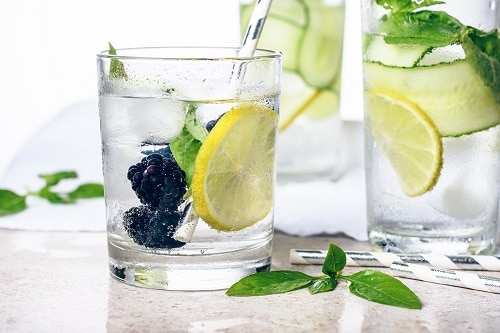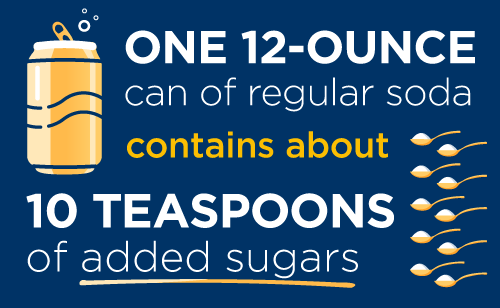Rethink Your Drink
The next time you go grocery shopping, read the nutrition labels on the items in your cart to see which ones have the most added sugars. You may be surprised to see the amount of added sugars in some drinks.
Sugary drinks are the leading source of added sugars in the American diet. These sweetened liquids include regular soda, fruit drinks, sports drinks, energy drinks, and sweetened waters. The flavored coffees we grab on the way to work and sweet drinks we order when eating out also count as sugary drinks. Adding sugar and flavored creamer to coffee and tea at home counts, too.
Amount of Sugar and Calories in Common Drinks
Sugar content derived from US Department of Agriculture Food Data Central
People who often drink sugary drinks are more likely to face health problems, such as weight gain, obesity, type 2 diabetes, heart disease, cavities, and gout, a type of arthritis.1-7
The latest guidelines [PDF-30.7MB] recommend that people 2 years and older keep their intake of added sugars to less than 10% of their total daily calories.8 For example, in a 2,000 calorie diet, no more than 200 calories should come from added sugars. Two hundred calories is about 12 teaspoons of added sugar in food and beverages combined. A 12-ounce regular soda has more than 10 teaspoons of added sugar, adding up to about total 150 calories. CDC research found about 30% of Americans ages two and older eat and drink high amounts of added sugar each day.8,9 Cutting out 2 regular sodas per day would reduce total calories by 2,100 in a week.9
Tricks to Rethink Your Drink

- Choose water (tap or unsweetened, bottled, or sparkling) over sugary drinks.
- Need more flavor? Add berries or slices of lime, lemon, or cucumber to water.
- Missing fizzy drinks? Add a splash of 100% juice to plain sparkling water for a refreshing, low-calorie drink.
- Need help breaking the habit? Don’t stock up on sugary drinks. Instead, keep a jug or bottles of cold water in the fridge.
- Water just won’t do? Reach for drinks that contain important nutrients such as low fat or fat free milk; unsweetened, fortified milk alternatives; or 100% fruit or vegetable juice first. (NOTE: Before infants are 12 months old, do not give fruit or vegetable juice. Juice after 12 months old is not necessary, but 4 ounces or less a day of 100% juice can be provided.)
- At the coffee shop? Skip the flavored syrups or whipped cream. Ask for a drink with low fat or fat free milk, an unsweetened milk alternative such as soy or almond, or get back to basics with black coffee.
- At the store? Read the Nutrition Facts label to choose drinks that are low in calories, added sugars, and saturated fat.
- On the go? Carry a reusable water bottle with you and refill it throughout the day.
- Still thirsty? Learn how to drink more water.
Remember that you can be a role model for your friends and family by choosing water and other healthy, low-calorie beverages.
A Note About Energy Drinks
Energy drinks are often marketed as products that increase energy. In addition to added sugar, these products may also contain large amounts of caffeine and other legal stimulants. Concerns have been raised about the potential health risks of these products, especially for young people.10-11 If you’re looking for a quick pick-me-up, alternatives to energy drinks include:
- Plain or unsweetened flavored water. Dehydration is often a reason for low energy.12
- Unsweetened tea. A number of tea flavors are available in naturally caffeinated varieties that can be enjoyed hot or cold. 13
- Hot or iced coffee.
- 100% fruit or vegetable juice. There are many types of juices and juice combinations. Find one that you enjoy!
- Whole fruit. Sometimes a snack can give you as much of a boost as a drink.
See more about energy drinks in children and adolescents.
Other Names for Added Sugar
According to the Food and Drug Administration, added sugars include sugars that are added during the processing of foods (such as sucrose or dextrose), foods packaged as sweeteners (such as table sugar), sugars from syrups and honey, and sugars from concentrated fruit or vegetable juices. Added sugars do not include naturally occurring sugars that are found in milk, fruits, and vegetables.14
If these appear in the ingredients list of your favorite beverage, you are drinking a sugar-sweetened beverage.
- Cane juice
- Corn syrup
- Dextrose
- Fructose
- Fruit juice concentrates
- Fruit nectars (such as agave nectar)
- Glucose
- High fructose corn syrup
- Honey
- Malt syrup
- Maple syrup and syrup
- Molasses
- Raw sugar
- Sugar
- Sucrose
- Sugar cane
- Malik V, Popkin B, Bray G, Desprs J-P, Hu F. Sugar-sweetened beverages, obesity, type 2 diabetes mellitus, and cardiovascular disease risk. Circulation. 2010;121(11):1356-1364.
- Drouin-Chartier JP, Zheng Y, Li Y, et al. Changes in Consumption of Sugary Beverages and Artificially Sweetened Beverages and Subsequent Risk of Type 2 Diabetes: Results From Three Large Prospective U.S. Cohorts of Women and Men. Diabetes Care. 2019;42(12):2181-2189.
- Malik VS, Hu FB. Sugar-Sweetened Beverages and Cardiometabolic Health: An Update of the Evidence. Nutrients. 2019;11(8):1840. Published 2019 Aug 8.
- Bernabe E, Vehkalahti MM, Sheiham A, Aromaa A, Suominen AL. Sugar-sweetened beverages and dental caries in adults: a 4-year prospective study. J Dent. 2014;42(8):952-958.
- Laniado N, Sanders AE, Godfrey EM, Salazar CR, Badner VM. Sugar-sweetened beverage consumption and caries experience: An examination of children and adults in the United States, National Health and Nutrition Examination Survey 2011-2014. J Am Dent Assoc. 2020;151(10):782-789.
- Valenzuela MJ, Waterhouse B, Aggarwal VR, Bloor K, Doran T. Effect of sugar-sweetened beverages on oral health: a systematic review and meta-analysis. Eur J Public Health. 2021;31(1):122-129.
- Ebrahimpour-Koujan S, Saneei P, Larijani B, Esmaillzadeh A. Consumption of sugar sweetened beverages and dietary fructose in relation to risk of gout and hyperuricemia: a systematic review and meta-analysis. Crit Rev Food Sci Nutr. 2020;60(1):1-10.
- Park S, Zhao L, Lee SH, Hamner HC, Moore LV, Galuska DA, Blanck HM. Children and Adolescents in the United States with Usual High Added Sugars Intake: Characteristics, Eating Occasions, and Top Sources, 2015–2018. Nutrients. 2023; 15(2):274. https://doi.org/10.3390/nu15020274
- Lee SH, Zhao L, Park S, Moore LV, Hamner HC, Galuska DA, Blanck HM. High Added Sugars Intake among US Adults: Characteristics, Eating Occasions, and Top Sources, 2015–2018. Nutrients. 2023; 15(2):265. https://doi.org/10.3390/nu15020265
- Dietary Guidelines for Americans, 2020-2025. Key Recommendation on Added Sugar [PDF-31.4MB].
- United States Department of Agriculture. Food Data Central.
- National Institutes of Health. National Center for Complementary and Integrative Medicine. Energy Drinks.
- Committee on Nutrition and the Council on Sports Medicine and Fitness. Sports drinks and energy drinks for children and adolescents: are they appropriate?. Pediatrics. 2011;127(6):1182-1189.
- Popkin BM, D’Anci KE, Rosenberg IH. Water, hydration, and health. Nutr Rev. 2010;68(8):439-458.
- US Department of Agriculture and US Department of Health and Human Services. Dietary Guidelines for Americans [PDF-31.4MB]. 2020-2025. P.36; 9th Edition.
- Food and Drug Administration. Added Sugars on the New Nutrition Facts Label.


